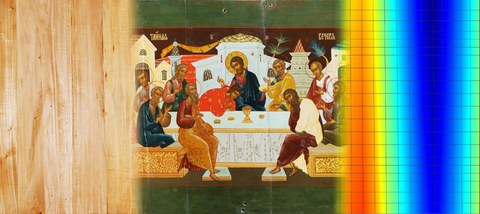Virtual Experiments for Wooden Artwork – VirtEx

Virtual Experiments for Wooden Artwork – VirtEx
The project Virtual Experiments for Wooden Artwork – VirtEx at the Technische Universität Dresden will conclude with a final international colloquium at 5 November 2021.
It will be held in digital form as an online conference. The colloquium language is English.
The VirtEx project. Within the research field of preventive conservation, the aim of the VirtEx project is to develop an objective, numerical tool for decision-making in conservation and restoration. Simulation models for the analysis of painted wooden artwork are developed using the Finite Element Method. The central object within the VirtEx project is an icon of the Russian Memorial Church in Leipzig. The numerical studies are accompanied by art technological, material and structural investigations on the icon, conducted by the interdisciplinary group of project partners. Finally, computer simulations shall predict the structural behaviour of wooden artwork within a fluctuating climate, in order to avoid damage and to determine climate regulations or other specific conservation measures.
The international colloquium. Interdisciplinarity is a key aspect in this research field. The communication between different disciplines can be challenging sometimes. In order to strengthen the link between theory and practice, between engineering science and conservation science, the lectures will be given by engineering scientists who have a strong connection to practical restoration and conservation projects. The colloquium addresses both, restorers and conservators, but also natural scientists and engineers in a broad sense. The aim of the contributions is to introduce the state of the art in this field to a broad audience.
Postprint. A high quality printed book of the lecture contributions will be published and is aimed to become a book on the state of the art of scientific engineering methods in the field of restoration and conservation of wooden cultural heritage objects.
Time: 5. November 2021, 08:45 - 16:00 (Timezone: UTC + 1)
Venue: online via zoom
Contributors:
- Michael Kaliske, Technische Universität Dresden (Germany)
- Łukasz Bratasz, Yale University (USA), Polish Academy of Sciences Krakow (Poland)
- Kristofer Gamstedt, Uppsala University (Sweden)
- Chiara Bertolin, Norwegian University of Science and Technology Trondheim (Norway)
- Akke S.J. Suiker, Eindhoven University of Technology (Netherlands)
- Emanuela Bosco, Eindhoven University of Technology (Netherlands)
- Joseph Gril, CNRS (National Centre for Scientific Research) (France)
- Michał Łukomski, Getty Conservation Institute (USA)
- Ottaviano Allegretti, National Research Council of Italy - the BioEconomy Institute (Italy)
To participate, you need to register via email until 3 November
The zoom link will be sent to you right before the colloquium.
Program (pdf)
9:00 Introduction
Prof. Dr. habil. Michael Kaliske, Technische Universität Dresden, Institute for Structural Analysis
Session 1 (state of knowledge, monitoring)
9:15 Preservation of wooden heritage objects: Needs and gaps in knowledge
Prof. Dr. Dr. habil. Łukasz Bratasz, Yale University (USA), Head of the Sustainable Conservation Lab; Polish Academy of Sciences Krakow (Poland), Jerzy Haber Institute of Catalysis and Surface Chemistry
9:50 Mechanical experiments needed to predict creep in large wooden objects in cultural heritage: Experiences from the Vasa ship
Dr. Reza Afshar, Prof. Dr. Kristofer Gamstedt, Uppsala University (Sweden), Department of Engineering Sciences
10:25 - 10:40 Break
Session 2 (numerical methods)
10:40 Cracking induced in historical art objects by indoor climate variations
Prof. Dr. Akke S.J. Suiker, Eindhoven University of Technology (Netherlands), Department of the Built Environment Applied Mechanics
11:15 Predicting craquelure and delamination mechanisms in panel paintings
Prof. Dr. Emanuela Bosco, Eindhoven University of Technology (Netherlands), Department of the Built Environment Applied Mechanics
11:50 Integration of experimental and numerical methods to study the mechanical risk conditions for the conservation of unique artpieces: The case of the Mona Lisa
Lorenzo Riparbelli, Prof. Dr. Joseph Gril, Prof. Dr. Luca Uzielli, CNRS (National Centre for Scientific Research), University Clermont Auvergne (France)
12:25 Inside the Icon: Experimental and numerical analysis of climate impacts on the damage potential of panel paintings
Prof. Dr. habil. Michael Kaliske, Oliver Tietze, Daniel Konopka, Technische Universität Dresden (Germany), Institute for Structural Analysis
13:00 - 13:45 Break
Session 3 (risk assessment, strategies, measures)
13:45 A new risk assessment tool which assesses the climate-induced mechanical stress and its strain energy density on Pine circular elements: preliminary investigation in view of the experimental and numerical modeling validation
Prof. Dr. Chiara Bertolin, Norwegian University of Science and Technology Trondheim (Norway), Department of Mechanical and Industrial Engineering
14:20 Problems and peculiarities of thin panel paintings: The effects of protective measures on the back side
Dr. Ottaviano Allegretti, CNR-IBE (National Research Council of Italy - the BioEconomy Institute)
14:55 Monitoring micro-changes in wooden artworks to support strategies for indoor climate management
Dr. Michał Łukomski, Getty Conservation Institute (USA)
15:30 Conclusion / Acknowledgement
